RHS'69
Fishing in Alaska
Tuesday, August 11, 2015
John Takara grabbed his rod and reel and headed way up north.
He takes you along for salmon fishing.
Fishing Alaska is an amazing experience. This was my third trip, each a unique adventure. It's so much fun, I'll be back in September when the Coho salmon are coming upriver.
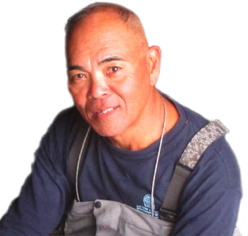
In mid-July this year, I, my son Jonathan, and two friends, Dennis Kam and Nelson Mashino spent a week at the Orca Adventure lodge, Cordova, Alaska. We came to fish for sockeye, the most delectable of the 5 salmon species that spawn in Alaska's rivers during the summer and fall.
Fishing in two rivers of the Copper River Delta, and in Prince William Sound fronting the lodge, our fishing adventure began slowly but soon developed into one of the best experiences ever. The first two days on the Eyak River, the four of us caught only 4 sockeye. I personally didn't catch any, hooking 2 that got away. We found that they came upriver at about 30 minute intervals swimming past our location in small schools numbering 4 to 10 individuals.
Returning to the lodge, we entertained ourselves fishing for the pink salmon spawning by the thousands in the rocky shoreline fronting the fishing lodge. The night before, we had stayed up to 11pm catching dozens of them. We released them all, having been told by locals that they weren't good to eat. This time, however, we grilled one and found them to be just fine so we began to keep our catch. We would repeat this activity every evening of our stay and each night after fishing, we'd clean fish, vacuum seal and freeze the filets, and process the eggs to make ikura. Each of us brought back 50 lbs of frozen Pink salmon filets and a quart of ikura.
With sockeye fishing slow on the Eyak River, the lodge owner, who is also a bush pilot, took his plane on a scouting trip to look for a better to place to fish. He found it on the upper Alaganik River, spotting a large school preparing to spawn. This was an isolated area and potentially difficult place to reach. Here, the river narrows, running swift and shallow, and trees fallen into the river make navigating treacherous. The plan was to have our fishing guide take Jonathan upriver to the fishing area on a jet boat carrying 2 canoes which we would use on our return down river. The two of them were prepared to haul the two canoes manually along the river bank if the jet boat couldn't reach the fishing area. This effort being too much for the 3 older guys, we took a different route, hiking 2.5 mile into Lake McKinley where the guide picked us up with the jet boat after reaching the fishing area with the canoes.
One day we decided to kayak 3 miles from the lodge up Prince William Sound to Humpback Creek, where, we were told, a large school of Pink salmon was congregating. We started out at 9am during the slack tide, the period between low and high tide when the currents are calm. It was a perfect day; the sun was shining, the water glassy, the temperature 60 degrees, the scenery stunning, and we were accompanied along the way with hosts of ravens, seagulls and a couple of Bald Eagles. After a leisurely one hour paddle, we reached the Creek. The fishing there was different than in front of the lodge. Because the tide was low, the school was outside the mouth of the creek. It was smaller and kept moving. We had to continually search for the fish. Still, after three hours we had 12 keepers. With the tide rising, we had lunch and enjoyed the beautiful paddle back to the lodge.
The fishing was great. We must've caught 20 in 3 hours. We confirmed that near spawning the sockeye get aggressive and will bite at lures. However, we were only able to keep 3 of the fish, as most were dark red in color, indicating they were near spawning. At this late stage they are not good for eating.
Reaching calm water below, we turned and watched in horror as the 2nd canoe, piloted by Dennis, ran straight into a log! The back of the canoe, pushed by the current, began to come around sideways threatening to capsize them. Fortunately, using his paddle and furious effort, Nelson was able to push off the log and straighten the canoe.
The rest of the trip downriver was through calmer waters and gratefully uneventful.
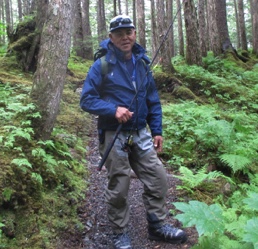
We entertained ourselves during the frequent down times by feeding the bald eagles that roosted in the tall pine trees across the river.
We had about one minute with each group trying to hook one.
Alaskan fishing regulations require that sockeye be hooked in the mouth using a single hook, a tricky requirement since they don't feed or chase lures.
The technicalities of how this is accomplished would require a treatise on fishing technique so let's just say, it made for a long day.
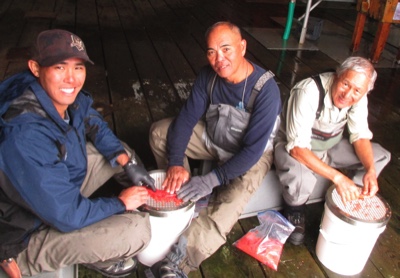
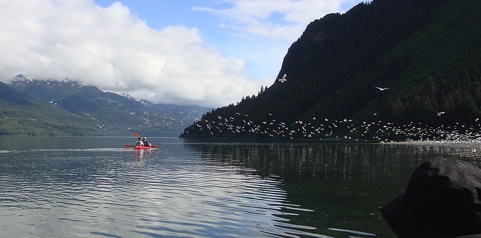

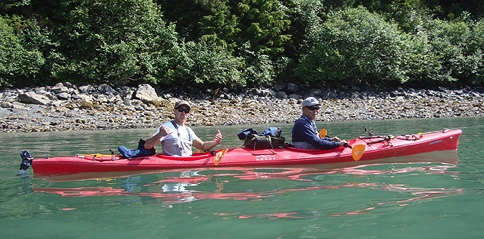
The canoe trip downriver was harrowing. We were inexperienced navigating a canoe, the water was swift, requiring quick reaction time and just 100 yards below the fishing area was a graveyard of trees lying in the river ready to grab and swamp any misdirected canoe. After a quick steering lesson from Jonathan, who is an experience kayaker, we headed downriver with my canoe leading the way. With Jonathan at the rear steering, we made it thru without incident.
